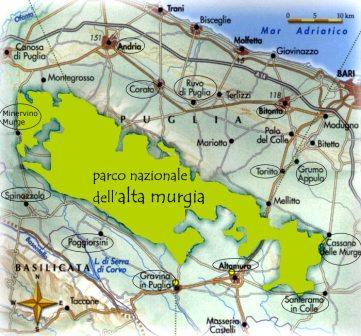"ALTA MURGIA": THE NATIONAL PARK
This National Park comprises an area of 68,077 ha about and is one of the most remarkable areas of the Southern Italy.
Alta Murgia refers to the north-west Murgia, namely a great part of Apulia among different cities, such as Bari, Barletta, Andria and Trani.
The plateau, made of limestone, takes the form of a prolonged quadrilateral in north-west, south-east direction. It’s not higher than 700 meters.
The long action of erosion by wind and rainwater shaped this extended plateau. It’s an exceptional wealth of karst phenomena. The most remarkable cracks of erosion are created when water is not swelled up in the cracks of limestone rocks, but it’s channeled after heavy rain. These cracks are called “lame” on site.
Among hypogean karst forms throughout the country, you can see wells, sinkholes (natural cavities through which water penetrates the soil to reach groundwater), chasms or graves, caverns and caves which are richly adorned with stalactites and stalagmites.
The graves are among the deepest ones of central and southern Italy, such as Faraulla (270m.). One of the biggest caves is the Christ Cave, in Cassano Murge area.
 |
Map of Alta Murgia Park |
PLANT LIFE
Along the northern border facing the Adriatic, we can find oaks. We suppose to find a herbaceous vegetation or low shrubs because of the outcropping limestone base with a land without a strong germination of tree species, a highly selective climate and a greater exposure to wind. Most of the northern and western Murge surface is currently covered by this kind of natural vegetation.
WILDLIFE
In this kind of habitat we can see a lot of small and medium-sized animals, such as insects and birds: the lark, the skylark, the crested lark and the woodlark.
The rapacious birds belong to another interesting bird family; in addition to the Hawk, the Kite, the black Kite, the Harrier and the Lanner, the Upper Murgia is home of one of the largest and important European populations of the Lesser Kestrel (Naumanni Hawk), commonly known as the Falco Grillaio.
Next to karst lakes, tanks or wells we can see amphibians such as the Italic Triton, the common toad, the tree frog, the Frog and the Apennine toad.
The arid and rocky area of the Upper Murgia is also perfect for many species of reptiles, such as the Kotschy Gecko and the leopard Columbo.
|
|
National Park of Alta Murgia |